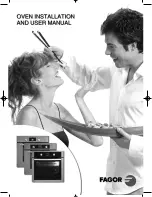
12 TROUBLESHOOTING GUIDE
CAUTION
1.
Check grounding before checking for trouble.
2.
Be careful of the high voltage circuit.
3.
Discharge high voltage capacitor.
4. When checking the continuity of the switches or the high voltage transformer, disconnect one lead wire from these parts and then check
continuity with the AC plug removed. To do otherwise may result in a false reading or damage to your meter.
When disconnecting a plastic connector from a terminal, you must hold the plastic connector instead of the lead wire and then disconnect it,
otherwise lead wire may be open or the connector cannot be removed.
5.
Be sure to ground any static electric charge built up in your body, before handling the D.P.C.
6.
A 230-240V AC is present at the shaded area ( ) of the power supply circuit board (Terminals of power relays and primary circuit of low voltage
transformer). When troubleshooting, be cautious of possible electrical shock hazard.
First of all operate the microwave oven following the correct operating procedures described on pages 3 of this service manual in
order to find the exact cause of any trouble.
NOTE:
If the unit shows faulty symptom as shown below, check the parts listed in possible cause column depending on
failure indication e.g. F81, F82 in the display.
[TROUBLE 1] Oven does not operate at all or oven does not start cooking.
DISPLAY
CONDITIONS
POSSIBLE CAUSE
TIMING OF FAILURE INDICATION
F33
Open temperature
sensor (exhaust)
1.
Temperature sensor failure
2.
Digital programmer circuit failure
3.
Loose connector CN4
It is appeared when failure occured.
F34
Short temperature
sensor (exhaust)
1.
Temperature sensor failure
2.
Digital programmer circuit failure
It is appeared when failure occured.
F44
1.
Shorted power select switch
2.
Shorted membrane switch
It is appeared 2 minuted after failure
occured.
F01
(With continuous
beep sounds)
Exhaust temperature
exceeds 120°C
1.
Burning food in the oven due to over cook
It is appeared when exhaust temperature
exceeds above 120°C.
F05
Memory failure
1.
Digital programmer circuit failure
No display
1.25A fuse blown
1.
Switch failure SW4, SW5, SW6, SW7
2.
Low-Voltage transformer failure
No display
1.25A fuse is OK
1.
Switch failure SW1, SW2, SW3
2.
Low voltage transformer failure
3.
Digital programmer circuit failure
F81
No voltage supply to
high voltage transformer
(upper)
1.
Relay failure RY-3
2.
10A fuse open
3.
Digital programmer circuit failure
It is appeared when cooking is completed.
F82
No voltage supply to
high voltage transformer
(lower)
1.
Relay failure RY-4
2.
10A fuse open
3.
Digital programmer circuit failure
It is appeared when cooking is completed.
F86
Shorted contacts of RY-
3
1.
Relay failure RY-3
2.
Digital programmer circuit failure
It is appeared when failure occured.
F87
Shorted contacts of RY-
4
1.
Relay failure RY-4
2.
Digital programmer circuit failure
It is appeared when failure occured.
22
NE-2156 / NE-2146 / NE-1656
Summary of Contents for NE-2156
Page 3: ...1 OUTLINE DIAGRAM 3 NE 2156 NE 2146 NE 1656...
Page 4: ...4 NE 2156 NE 2146 NE 1656...
Page 5: ...2 OPERATION PROCEDURE NE 2156 NE 1656 5 NE 2156 NE 2146 NE 1656...
Page 6: ...6 NE 2156 NE 2146 NE 1656...
Page 7: ...7 NE 2156 NE 2146 NE 1656...
Page 8: ...8 NE 2156 NE 2146 NE 1656...
Page 9: ...9 NE 2156 NE 2146 NE 1656...
Page 10: ...3 OPERATION PROCEDURE NE 2146 10 NE 2156 NE 2146 NE 1656...
Page 11: ...4 SCHEMATIC DIAGRAM NE 2146 11 NE 2156 NE 2146 NE 1656...
Page 12: ...5 SCHEMATIC DIAGRAM NE 2156 NE 1656 12 NE 2156 NE 2146 NE 1656...
Page 23: ...13 EXPLODED VIEW AND PARTS LIST 23 NE 2156 NE 2146 NE 1656...
Page 28: ...16 ESCUTCHEON BASE ASSEMBLY 28 NE 2156 NE 2146 NE 1656...
Page 29: ...29 NE 2156 NE 2146 NE 1656...
Page 33: ...33 NE 2156 NE 2146 NE 1656...














































